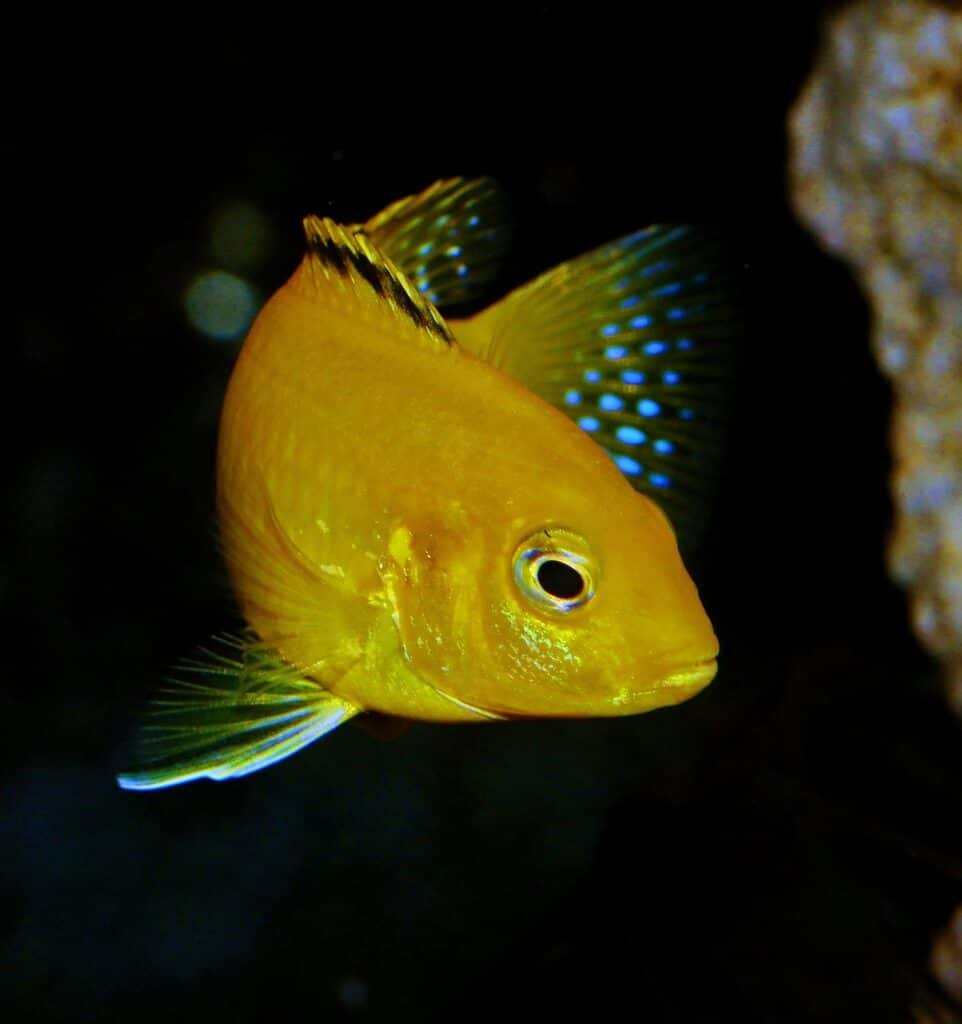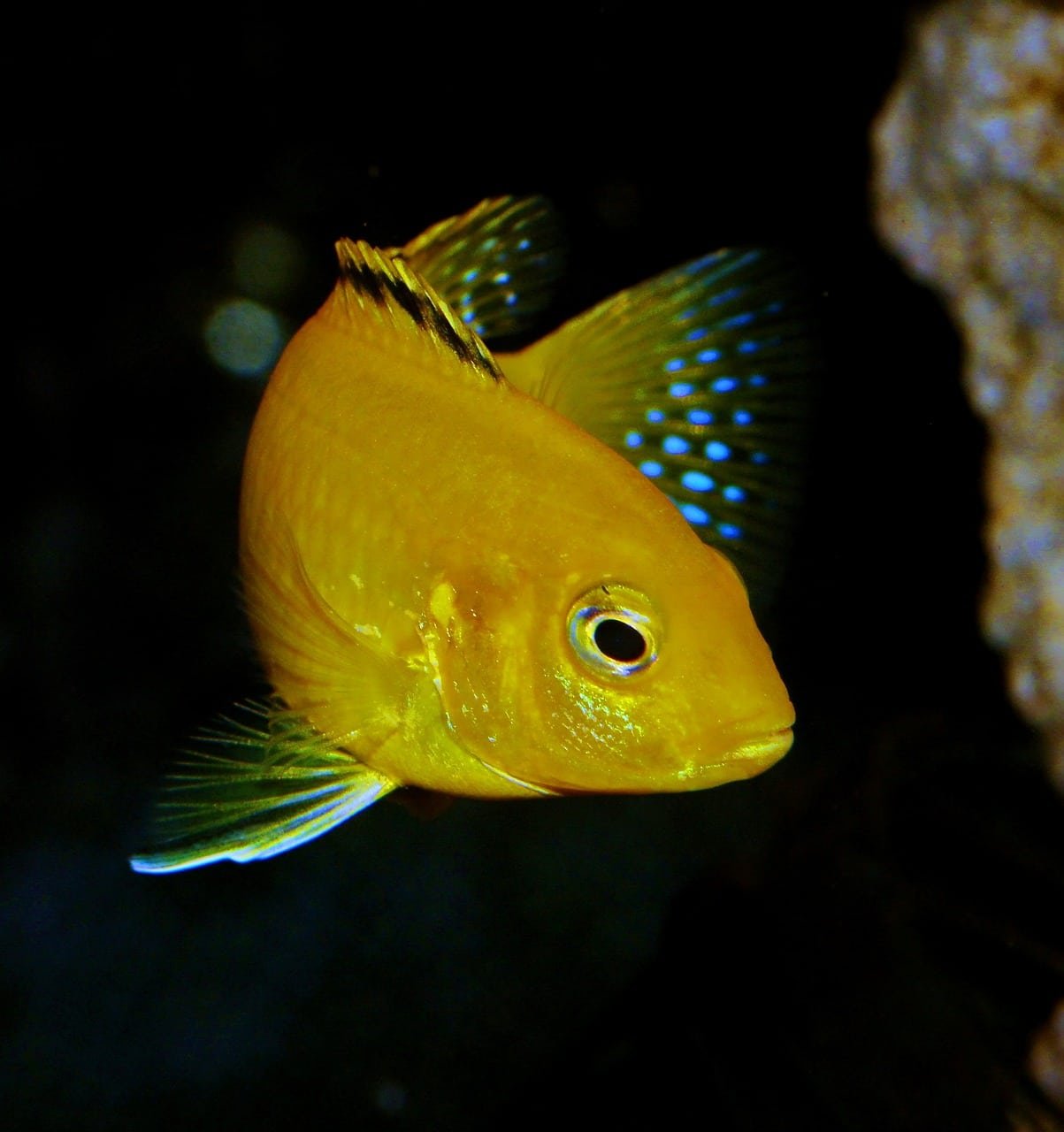The Yellow Lab Cichlid (Labidochromis caeruleus), also known as the Electric Yellow Cichlid, is a popular choice among aquarists due to its vibrant yellow coloration and relatively peaceful nature. This guide will cover everything you need to know about caring for Yellow Lab Cichlids, including male vs. female differences, tank mates, size, and breeding.
| Topic | Information |
|---|---|
| Introduction | Native to Lake Malawi, East Africa. Known for vibrant yellow color and mild temperament. |
| Male vs. Female Yellow Lab Cichlids | Coloration: Males are more intense yellow. Size: Males up to 4 inches, females around 3 inches. Fins: Males have elongated fins with blue hue. Egg Spots: Males have more prominent egg spots. |
| Tank Mates | Suitable: Other Mbuna Cichlids (Red Zebra, Acei), Peaceful Cichlids, Catfish (Bristlenose Pleco, Synodontis), Non-Cichlids (Rainbowfish). Avoid: Overly aggressive species. |
| Size and Lifespan | Size: 3-4 inches. Lifespan: Up to 10 years. |
| Tank Size | Minimum 30 gallons for a single fish; 55 gallons or larger for groups. |
| Tank Setup | Substrate: Sand or fine gravel. Rocks and Caves: For hiding spots and territories. Plants: Hardy species like Anubias or Java Fern. Water Parameters: 76-82°F, pH 7.8-8.6, hardness 10-20 dGH. Filtration: High-quality filter. |
| Diet | Primary Diet: High-quality pellets or flakes. Vegetables: Blanched spinach, peas, zucchini. Live/Frozen Foods: Brine shrimp, daphnia, bloodworms. Avoid: Overfeeding high-protein foods. |
| Breeding | Selecting Pair: Healthy, mature fish. Breeding Tank: Separate tank with optimal conditions (80°F, pH 8.0). Spawning Process: Female mouthbrooder. Caring for Fry: Feed crushed flake food or fry food. |
| Common Health Issues | Ich: White spots, scratching. Treat with temperature increase and medication. Malawi Bloat: Swelling, loss of appetite. Treat with reduced protein, improved water quality, anti-parasitic medication. |
| Albino Yellow Lab Cichlids | Pale yellow with red eyes. Same care as standard Yellow Labs but more sensitive to bright light. |
| Hybrids | Crossbreeding with other Mbuna species. Unpredictable temperaments and care requirements. |
| For Sale | Purchase from reputable breeders or stores. Look for bright colors, clear eyes, and active behavior. Prices range from $5 to $20. |
Introduction to Yellow Lab Cichlids
Native to the rocky shores of Lake Malawi in East Africa, Yellow Lab Cichlids are known for their striking yellow color and mild temperament compared to other African cichlids. They are a great addition to any freshwater aquarium, especially for those looking to add a splash of color.
Male vs. Female Yellow Lab Cichlids
Distinguishing between male and female Yellow Lab Cichlids can be challenging, especially when they are young. However, there are some subtle differences:
- Coloration: Males often have more intense yellow coloration, while females may appear slightly paler.
- Size: Males are generally larger than females, reaching up to 4 inches, while females typically grow to about 3 inches.
- Fins: Males may have more elongated dorsal and anal fins with a slight blue hue on the edges, which is less pronounced in females.
- Egg Spots: Males usually have more prominent and numerous egg spots on their anal fins compared to females.
Yellow Lab Cichlid Tank Mates
Choosing the right tank mates for Yellow Lab Cichlids is crucial to maintain a peaceful environment. Here are some suitable options:
- Other Mbuna Cichlids: Species like the Red Zebra Cichlid and the Acei Cichlid can coexist well with Yellow Labs due to similar water and diet requirements.
- Peaceful Cichlids: Avoid overly aggressive species but consider cichlids with a similar temperament.
- Catfish: Species like the Bristlenose Pleco or Synodontis Catfish can help keep the tank clean without bothering the Yellow Labs.
- Non-Cichlids: Larger, fast-swimming fish like Rainbowfish can also make good tank mates.

Yellow Lab Cichlid Size and Lifespan
Yellow Lab Cichlids typically reach an adult size of 3-4 inches. They have a relatively long lifespan for aquarium fish, living up to 10 years with proper care.
Tank Size for Yellow Lab Cichlids
A spacious tank is essential for the well-being of Yellow Lab Cichlids. The minimum recommended tank size is 30 gallons for a single fish, but a 55-gallon tank or larger is ideal for housing a small group and providing adequate space for swimming and territorial behavior.
Yellow Lab Cichlid Tank Setup
Creating an ideal environment for your Yellow Lab Cichlid involves several key elements:
- Substrate: Use sand or fine gravel to mimic their natural habitat.
- Rocks and Caves: Provide plenty of hiding spots and territories with rocks, caves, and other decorations.
- Plants: While Yellow Labs may not uproot plants as aggressively as other cichlids, choose hardy species like Anubias or Java Fern.
- Water Parameters: Maintain a temperature of 76-82°F, pH between 7.8 and 8.6, and hardness of 10-20 dGH.
- Filtration: Use a high-quality filter to keep the water clean and well-oxygenated.
Yellow Lab Cichlid Diet
Yellow Lab Cichlids are omnivorous but have a preference for plant-based foods. A balanced diet includes:
- High-Quality Pellets or Flakes: Choose cichlid-specific products with a good mix of protein and vegetable matter.
- Vegetables: Offer blanched spinach, peas, or zucchini.
- Live or Frozen Foods: Supplement with brine shrimp, daphnia, or bloodworms occasionally for added protein.
- Avoid: Avoid overfeeding high-protein foods, which can lead to digestive issues.
Breeding Yellow Lab Cichlids
Breeding Yellow Lab Cichlids can be a rewarding experience with the right conditions:
Selecting a Breeding Pair
Choose healthy, mature fish with vibrant coloration. Ensure the pair is well-fed and comfortable in their environment.
Breeding Tank Setup
Set up a separate breeding tank with plenty of hiding spots and maintain optimal water conditions (temperature around 80°F, pH 8.0).
Spawning Process
Yellow Labs are mouthbrooders. The female will lay eggs and then pick them up in her mouth. The male will fertilize the eggs through a process called egg-spot fertilization, where the female nips at the male’s egg spots, thinking they are eggs, and the male releases sperm.
Caring for Fry
The female will carry the eggs in her mouth for about 3 weeks until they hatch. Once released, feed the fry with crushed flake food or specialized fry food.
Common Health Issues and Treatments
Yellow Lab Cichlids are generally hardy but can be susceptible to certain health issues if not properly cared for:
Ich (White Spot Disease)
Symptoms: White spots on the body and fins, scratching against objects. Treatment: Increase tank temperature to 86°F for a few days and use an ich treatment.
Malawi Bloat
Symptoms: Swelling, loss of appetite, rapid breathing. Treatment: Reduce protein intake, improve water quality, and use anti-parasitic medication.
Albino Yellow Lab Cichlids
Albino Yellow Lab Cichlids are a rare but beautiful variation, characterized by their pale yellow color and red eyes. They require the same care as standard Yellow Labs but are more sensitive to bright light and may need additional hiding spots.
Yellow Lab Cichlid Hybrids
Hybrid Yellow Lab Cichlids can result from crossbreeding with other Mbuna species. While hybrids can be unique and interesting, they may have unpredictable temperaments and care requirements.
Yellow Lab Cichlids for Sale
When purchasing Yellow Lab Cichlids, choose reputable breeders or aquarium stores to ensure healthy fish. Look for bright colors, clear eyes, and active behavior. Prices can vary based on size and quality, typically ranging from $5 to $20.
Conclusion
Yellow Lab Cichlids are a stunning addition to any freshwater aquarium, offering vibrant colors and engaging behaviors. By providing a suitable habitat, balanced diet, and attentive care, you can enjoy the beauty and charm of these fish for many years. Whether you’re a novice or experienced aquarist, the Yellow Lab Cichlid is sure to captivate your interest and bring life to your aquarium.
Discover more from EMMOCEB
Subscribe to get the latest posts sent to your email.






